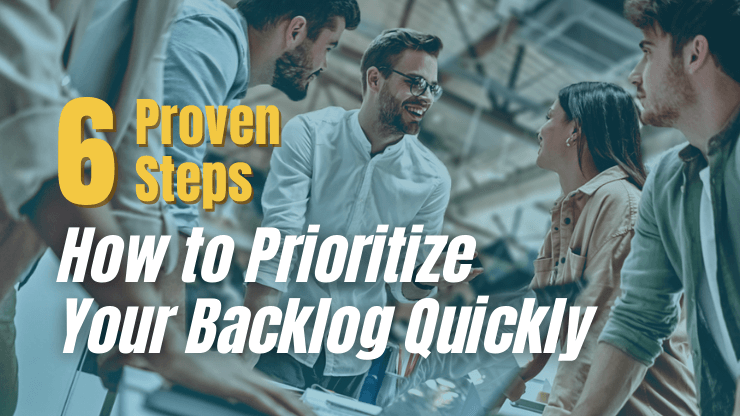Creating a well-prioritized product backlog is no easy task, especially with conflicting input from stakeholders and limited data from customers.
In fact, 25% of product managers say setting product roadmap priorities without customer feedback is their most significant challenge, and many spend nearly 2 hours every day on it!
That’s why we’re sharing 6 simple steps to eliminate the guesswork and prioritize your product backlog quickly.
By the end of this article you’ll be able to:
- Understand the benefits of having a well-organized and prioritized backlog
- Involve stakeholders in the process of prioritizing a backlog
- Use the best practices for organizing a backlog
- Prioritize your backlog using different criteria
What is a product backlog?
A product backlog is a list of tasks or features that either need to be completed before a product launch or before a new version of the product is released to customers. It is typically maintained by a product manager and serves as a repository for all of the work that needs to be completed by the product development team, including:
- Features that need to be developed
- Bugs that need to be fixed
- Enhancements that need to be added
- Knowledge acquisition required to develop a product
The backlog items should be regularly reviewed and updated to ensure that they accurately reflect the current state of the product and the demands of the customer.
What are the benefits of effective product backlog prioritization?
Product managers have a lot of product related tasks on their plate, such as ensuring the product meets customer needs, staying within development budget, and staying on schedule. At the same time, they must navigate the competing interests of various stakeholders, from the development team to sales and marketing. While it may be difficult to justify the time spent on product backlog prioritization, the benefits are numerous.
Effective product backlog prioritization can:
- Help in making informed resource allocation decisions
- Promote alignment of product strategy with customer needs
- Enhance visibility of highest priority deliverables
- Provide a better understanding of product scope
- Enable faster delivery of working software as well as software updates
- Facilitate early identification of risks and blockers
6 proven steps to prioritize backlog items
If you’re ready to prioritize your backlog items, you’re in the right place. In this section we’ll combine several proven product backlog prioritization techniques into 6 steps that you can start following today to get your backlog items under control.
Define clear criteria for prioritization
Before you start wading through your backlog, you should define what criteria you will use to prioritize each backlog item. Doing so will provide a clear basis for decision-making, including helping you to select a framework in step #2 that is most aligned with your needs.
The criteria you define should be aligned to your project’s overall goals and KPIs. In other words, look at the big picture. Potential prioritization criteria could be:
- Long-term product strategy: Assign different priorities based on how aligned an item is to meeting long-term product strategy goals.
- Customer satisfaction: Organize the backlog based on immediate customer requests or what would provide the most customer value.
- Business value: Prioritize tasks that offer the greatest potential benefit to the business, which typically means bottom-line revenue.
- Development cost: Assign the lowest priority to backlog features and bug fixes that require the highest cost and assign the highest priority to backlog items that require the lowest cost.
- Cost of delay: Take into account the cost to the business if a feature or fix is not implemented.
- Timeframe: Consider the time required to complete tasks as you assign priorities.
- Risk: Assign a low priority if a certain feature comes with a high degree of risk and vice versa.
Use a simple and consistent framework
Now that you’ve defined the criteria that will be used to set priorities, you need to select a product backlog prioritization framework that will dictate how you actually complete the backlog prioritization work, day in and day out.
Let’s look at a few frameworks that are available:
MoSCoW method (Must Have, Should Have, Could Have, and Won't Have) When using the MoSCoW Method, Must Have items must be features that are considered essential to deliver the product. Should Have items are those that are desired but not essential to the product's success. Could Have items are those that could be included if there is enough time and resources. Won't Have items are backlog items that are not going to be included in the product.
Eisenhower matrix: This model uses a 2x2 matrix to categorize a given feature into one of four quadrants depending on its urgency and importance. Urgent and important tasks should be done first, followed by important tasks that are not urgent. Tasks that are urgent but not important should be delegated, and tasks that are neither urgent nor important should be eliminate
Kano model: This model relies on the idea that customer satisfaction is determined by a combination of both expected features and unexpected features. Features that are expected should be prioritized higher than those that are unexpected.
RICE method (Reach, Impact, Confidence, and Effort). When using this model, Reach is a measure of how many users will be affected by the feature. Impact is a measure of how much value the feature will provide. Confidence is a measure of how confident the development team is that the feature will be successful. Effort is a measure of the amount of time and resources needed to develop the feature.
Stack ranking: This prioritization technique is used to prioritize a backlog by ranking features based on their importance and urgency, with the most important and urgent features being placed at the top of the stack. Features are then placed in descending order of importance and urgency.
Weighted shortest job first (WSJ): This approach to prioritization prioritizes work based on the relative cost of delay for each job, weighted against its size. This method emphasizes the importance of delivering early outcomes to customers, by considering the value of the job, the cost of delay, and the size of the job. The cost of delay is the estimated negative impact of delaying a job, such as lost revenue or customer dissatisfaction.
Focus on long-term product strategy
With your prioritization criteria defined and a working model selected, it’s time to deep dive into your long-term product strategy. As a product manager, it is your job to ensure the long-term success of your product, and so this is a critical piece of the equation when you are working through product backlog prioritization.
If you don’t already have a product strategy in place, you should analyze customer feedback, research industry trends, and develop a product roadmap that reflects the organization’s overall strategy. Use this to identify the most important features that will have the greatest impact on the product’s success and ensure that the product roadmap is focused on long-term goals and not just short-term wins.
Don’t be afraid to say “no”
You are the gatekeeper for your product, and as such, you can’t be afraid to tell people “no.” Not every proposed feature or request can be a high priority. It is your job to establish clear boundaries around the product backlog, so you can tightly control what does and does not get to land in the next sprint backlog.
To begin embracing this mentality, you can:
- Create a culture of transparency by communicating your criteria for evaluating requests and ideas, a timeline for responding to requests, and what your decision-making framework looks like.
- Establish clear channels for stakeholders to provide input and feedback, and make sure this feedback is documented and shared with the appropriate stakeholders.
- Always provide feedback to stakeholders on why their request has been declined and emphasize the importance of focusing on the most important items in the product backlog.
- Stand firm in your decisions. Be clear and firm when you do need to say “no.”
Consider dependencies
Not all items in your backlog are independent from each other. In fact, most probably aren’t! Considering dependencies is a crucial backlog prioritization technique to ensure priorities are set in a logical order for actual implementation.
Dependencies fall into two main categories:
- Task A must be completed before it is possible to complete Task B. In this case, Task A is in the critical path - in other words, Task B is dependent on Task A.
- Task A, Task B, and Task C must all be completed before a particular Feature is considered complete. In this case, a particular Feature is dependent on a group of tasks being completed.
Communicate with stakeholders
As a product manager, you are no stranger to communication. When handling backlog prioritization it is essential to have a formal communication plan established to avoid confusion or frustration from the various groups involved in product development. We recommend:
- Establishing a clear understanding of the stakeholders’ goals and objectives on an ongoing basis. Knowing what each person cares about and what their needs are will help you to tailor your communication strategies accordingly.
- Communicating the product roadmap, timeline and milestones to the stakeholders. This should include any changes or updates that may affect the product’s features or capabilities.
- Keeping stakeholders informed of progress on the backlog. This can include providing regular updates on the progress of tasks and schedules. The more consistent you are, the better.
- Seeking feedback on the backlog. This can include soliciting feedback on the prioritization of tasks and requesting feedback on any changes that may need to be made. Opening yourself up to feedback helps establish a culture of transparency and collaboration.
- Explaining why certain tasks are being prioritized over others. This should include providing a rationale for why certain tasks are more important than others and why they must be completed before others.
Tips for how to prioritize backlog for agile software development
Agile teams rely on collaborative, rapid iteration to deliver value to customers quickly. An effective prioritization strategy is key to successful delivery. At the beginning of each sprint, the team works together to prioritize the work items in the backlog in order to focus on delivering the most important items first.
- Choose the right methodology: Agile teams do not have to employ any particular prioritization methodology. However, you should choose one that aligns with the unique needs and day-to-day work flows of your Agile team, which may look different than teams who do not use Agile.
- Involve the whole team: When using Agile, it’s important to make the prioritization process collaborative. All team members should understand the various tasks in the backlog and the importance of each to ensure the best decisions are being made during the prioritization process.
- Group tasks by sprint: As you assess priorities, consider what group of tasks can be implemented together as part of an upcoming sprint. Use this methodology to organize your backlog in a way that lends itself to Agile sprint-based implementation.
Conclusion
By following these 6 steps, product backlog prioritization becomes a much simpler process. By defining criteria for prioritization, selecting a framework to work within, focusing on the long-term product strategy, saying “no” to some requests, considering dependencies, and communicating with stakeholders, product managers can quickly and effectively prioritize their backlog and ensure that the most important tasks are completed first. This will lead to more efficient delivery of working software, better customer satisfaction and greater success for the product.

